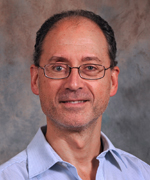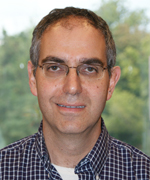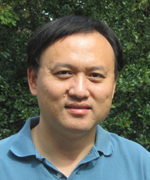Colleagues: Recently Tenured
MANFRED BOEHM, M.D., NHLBI
Senior Investigator, Center for Molecular Medicine

Education: University of Heidleberg, Germany (M.D.)
Training: Residency in internal medicine at the Franz Volhard Clinic (Berlin); research fellow at Max Delbrueck Center for Molecular Medicine (Berlin)
Came to NIH: In 1999 as a research fellow in NHLBI; became investigator in 2003
Outside interests: Spending time with his family
Research interests: My primary research interests are in vascular biology and the genetics of vascular remodeling in human diseases. My group developed complex animal models and patient-specific disease models, including induced-pluripotent-stem-cell–based systems, to understand the cellular and molecular mechanisms of vascular remodeling in rare or unknown inherited and acquired vascular diseases. We revealed new signaling pathways pivotal for balanced vascular wound repair, described a new concept of cellular contributions during vascular remodeling, and identified a new inherited vascular disease that causes arterial calcifications in adults. By gaining a more comprehensive knowledge of the cellular contributions and pathways involved in vascular remodeling, we hope to contribute to the development of potential therapeutic applications in regenerative medicine.
JASON BRENCHLEY, PH.D., NIAID
Senior Investigator, Laboratory of Molecular Biology

Education: Idaho State University, Pocatello, Idaho (B.S. in microbiology and chemistry; M.S. in chemistry); University of Texas Southwestern Medical Center at Dallas (Ph.D., Immunology)
Training: Postdoctoral fellowship in NIAID’s Vaccine Research Center
Came to NIH: For training in 2004; in 2008 joined the Laboratory of Molecular Microbiology
Selected professional activities: Deputy director, Wellcome Trust NIH Ph.D. Program: Scientific Advisory Committee member of amfAR, the Foundation for AIDS Research
Outside interests: Snowboarding; hiking; fishing
Research interests: We aim with our work to better understand the mechanisms that underlie the progression of human immunodeficiency virus (HIV) disease. The immune system, particularly its T-cell arm, plays a central role in HIV pathogenesis. Our long-term goal is to use the knowledge gained through these studies to develop novel therapeutic approaches. We use multiple nonhuman primate models with differing disease progression courses. We also study T-cell immunology in people infected with HIV and nonhuman primates infected with simian immunodeficiency virus (SIV) to elucidate mechanisms of disease progression. In one of our main areas of research, we are investigating the mechanisms underlying lack of disease progression in natural hosts of SIV. Several species of African nonhuman primates are naturally infected with SIV but do not develop simian AIDS. SIV-infected African green monkeys, for example, are capable of downregulating the CD4 receptor for SIV. We are studying the molecular mechanisms responsible for this downregulation and trying to determine whether other natural hosts for SIV are also able to downregulate CD4.
In a study with Asian macaques, we have shown that one cause of immune activation during the chronic phase of SIV infection is the translocation of microbial products from the lumen of the gastrointestinal tract into peripheral circulation. Moreover, our data suggest that the epithelial barrier of the gastrointestinal tract is damaged during chronic infection and allows microbial products to translocate directly into the lining. In our studies with pigtail macaques, we aim to link the rapid disease progression with increased microbial translocation. We will then study therapeutic interventions aimed at decreasing microbial translocation and disease progression in these animals.
SERGI FERRÉ, M.D., PH.D., NIDA
Senior Investigator; Chief, Integrative Neurobiology Unit

Education: Faculty of Medicine, Central University of Barcelona, Spain (M.D.); Faculty of Medicine, Autonomous University of Barcelona, Spain (Ph.D.)
Training: Residency in neurology, Hospital de Sant Pau, Faculty of Medicine, Autonomous University of Barcelona; postdoctoral training at the Karolinska Institute (Stockholm)
Before coming to NIH: Tenured investigator, Spanish Research Council, Barcelona; guest scientist at the Karolinska Institute
Came to NIH: In October 2000
Selected professional activities: Guest professor in biochemistry and molecular biology at the University of Barcelona; adjunct associate professor in pharmacology and experimental therapeutics at the University of Maryland School of Medicine (Baltimore)
Outside interests: Opera singing; swimming; running; spending time with family
Research interests: We are interested in the role of receptor heteromers as targets for drug development in neuropsychiatric disorders and drug addiction. Receptor heteromers are higher-order molecular entities that have unique biochemical and functional properties that may be harnessed for therapeutic purposes. Our research deals with the discovery of heteromers of receptors that are localized in brain circuits involved in addictive behaviors and include metabotropic receptors (G-protein-coupled receptors) such as those for dopamine, glutamate, cannabinoid, and adenosine. We analyze the biochemical and pharmacological properties of these receptors at the cellular level as well as in vivo.
At the cellular level, we use mammalian cell lines transfected with the receptors to demonstrate receptor heteromerization. We then look for the unique receptor heteromer’s biochemical properties, which can be used as a “biochemical fingerprint” to identify it in the brain. We use in vivo models—including intracranial electrical stimulation, in vivo microdialysis, and functional magnetic resonance imaging—to evaluate the functional significance of receptor heteromers. The cellular and in vivo models complement each other and are the basis for finding receptor heteromer–selective drugs.
MICHAEL SACK, M.D., PH.D., NHLBI
Senior Investigator, Laboratory of Mitochondrial Biology and Metabolism

Education: Medical School: University of the Witwatersrand, South Africa (MBBCh, MSC in medicine); University of Cape Town, Medical School, South Africa (Ph.D. in molecular biology)
Training: Residency in internal medicine at Georgetown University Medical Center (Washington, D.C.); cardiology fellowship at Washington University Medical Center, Barnes Hospital (St Louis, Mo.)
Before coming to NIH: Senior lecturer at University College London Medical School; assistant professor at the University of Cape Town Medical School, South Africa
Came to NIH: In January 2003
Selected professional activities: Organized Keystone Mitochondrial Meeting and International Mitochondrial Meetings at NIH; established a cardiovascular disease–discovery clinical protocol enabling research into uncommon diseases with cardiovascular risk or manifestations
Outside interests: Spending time with family and friends; hiking; cooking; reading nonfiction literature; following European soccer
Research interests: My laboratory focuses on the biology of mitochondrial regulation in diabetes and cardiovascular disease. We are investigating the role of the mitochondrial acetylome (the complete set of acetylated mitochondrial proteins) as a nutrient and caloric-load sensing program in modulating mitochondrial homeostasis. In one of our studies, we are identifying and characterizing the counter-regulatory mitochondrial acetyltransferase molecular machinery of the protein sirtuin 3 (SIRT3). We recently showed that SIRT3-dependent deacetylation of mitochondrial proteins increases acetaminophen liver toxicity. We have also identified a principal component of the mitochondrial acetyltransferase program and are exploring its role in mitochondrial function and in caloric-excess-associated diseases.
We are also studying the protein Parkin, which plays a pivotal role in mitochondrial quality control and when mutated is linked to some cases of premature-onset Parkinson disease. We were surprised to find that Parkin stabilizes the fatty acid translocase CD36 and that Parkin deficiency protects against fatty liver and insulin resistance in mice. We are now exploring this interaction between lipid metabolism and the pathophysiology of Parkinson disease in patients with Parkin mutations who are participating in a study at the Clinical Center.
KELLY TEN HAGEN, PH.D., NIDCR
Senior Investigator; Chief, Developmental Glycobiology Section

Education: Cornell University, Ithaca, N.Y. (B.S. in biology); Stanford University, Stanford, Calif. (Ph.D. in genetics)
Before coming to NIH: Research assistant professor at the University of Rochester (Rochester, N.Y.)
Came to NIH: In 2001 as senior research fellow in NIDDK; in 2005, was appointed chief of NIDCR’s Developmental Glycobiology Unit
Selected professional activities: Federal liaison for the Society for Glycobiology; editorial board member for Glycobiology and the Journal of Biological Chemistry
Outside interests: Skiing; ice skating; traveling; seeing movies; enjoying relaxing rides home on I-270
Research interests: Cells of the body are decorated with a variety of sugars or more complex carbohydrates that serve many diverse functions. These molecules not only act as a protective barrier on the outside of the cell, but also play a role in communication and signaling events in many systems. Our group studies one type of sugar addition to proteins—mucin-type O-linked glycosylation, which is initiated by the polypeptide GalNAc transferase enzyme family. It is known that O-glycosylation of proteins is associated with several human diseases, but the mechanism is not fully understood. My lab is trying to determine how O-glycosylation influences basic biological processes in development and disease.
O-glycosyltransferases are components of the secretory apparatus and responsible for the modification of secreted and membrane-bound proteins. We hypothesize that the modifications play crucial roles in the secretion, localization, stability, and function of proteins and may influence cell adhesion, communication, morphology, and proliferation. Using Drosophila melanogaster, we have determined that at least five members of the multigene family are essential for fruit fly viability.
We have also discovered a role for one O-glycosyltransferase in the secretion of an extracellular matrix integrin ligand that influences matrix composition and cell adhesion during Drosophila development. We have also demonstrated that another O-glycosyltransferase can influence extracellular matrix composition during mammalian development, with resultant effects on cell proliferation and organ growth. Our studies highlight novel roles for O-glycosylation in conserved cell biological processes and may elucidate how changes in this modification contribute to disease susceptibility and progression.
KAI YU, PH.D., NCI-DCEG
Senior Investigator, Biostatistics Branch

Education: Fudan University in Shanghai, China (B.S. in mathematics); Beijing University of Posts and Telecommunications in Beijing, China (M.S. in applied mathematics); University of Pittsburgh (Ph.D. in biostatistics)
Training: Postdoctoral training in statistical genetics at Stanford University (Calif.)
Before coming to NIH: Statistical geneticist at Millennium Pharmaceuticals, Inc. (Cambridge, Mass.); research assistant professor of biostatistics at Washington University (St. Louis, Mo.)
Came to NIH: In November 2005
Outside interests: Swimming; playing basketball with his son
Research interests: My research specializes primarily in statistical genetics and addresses challenges in the design and analysis of modern genomic studies. Since beginning my biostatistics research at NCI, I have been the lead statistician for the design and analysis of a variety of genetic epidemiology studies, with a major emphasis on genome-wide association studies (GWAS) of cancer. GWAS—and other studies that exploit high-throughput technologies for measuring genes, metabolites, and other biological markers—are proving to be powerful research approaches. The complex information collected by those studies poses a wide range of statistical questions that have motivated my methodologic work.
I also developed an adaptive design framework, a multistage design that relies on accumulating data to modify aspects of a study without undermining its validity and integrity. The framework can be used to design a follow-up study for validating previous genetic association findings while accounting for the potential of “winner’s curse” (a genetic marker chosen for replication because of an extreme observed effect size that tends to be less extreme in the second study).
Recently, I proposed an efficient P-value evaluation method for resampling-based procedures that can reduce computing time by a factor ranging from 1/100 to 1/500,000. The method can be applied to a test statistic with an unusually large value that only occurs—or can be observed—less than one in a million times by chance (a common occurrence in genomic studies in which over a million markers are evaluated).
This page was last updated on Friday, April 29, 2022
